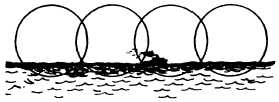| |
lenses may melt, allowing moisture to cause the lenses
to fog or bubble.
Above all, keep them clean. You must be careful,
however, not to damage the lenses. First, blow off loose
dust, then breathe on the lenses (except in freezing
weather), and gently clean them with lens paper. Rags,
plain paper, handkerchiefs, or your sleeve or shirttail
should not be used, as they might scratch the lens.
VISUAL SEARCH PROCEDURES
Effective visual searching does not come naturally;
a lookout must learn through practice. In the daytime
a person's eyes must stop on an object in order to see
it. Try moving your eyes across the water rapidly from
object to object and note that as long as your eyes are
in motion, you see almost nothing. Now allow your
eyes to move in short steps from object to object and
you can really see what is there.
This is known as the step-by-step method. (See
figure 4.)
A ship's lookout cannot be too well-trained, too
alert, or too much on the job. Remember—the safety
of the ship and the personnel on board depend on the
lookout. By seeing things and reporting them quickly
Figure 4.—Scanning, using the step-by-step method.
10
|

